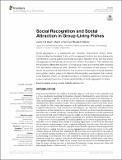Files in this item
Social recognition and social attraction in group-living fishes
Item metadata
| dc.contributor.author | Ward, Ashley J. W. | |
| dc.contributor.author | Kent, Maud I. A. | |
| dc.contributor.author | Webster, Michael M. | |
| dc.date.accessioned | 2020-02-04T16:30:02Z | |
| dc.date.available | 2020-02-04T16:30:02Z | |
| dc.date.issued | 2020-02-02 | |
| dc.identifier | 266204930 | |
| dc.identifier | 36f179f0-5b26-4515-b43b-ee3fda0b0907 | |
| dc.identifier | 85079616269 | |
| dc.identifier | 000731571700001 | |
| dc.identifier.citation | Ward , A J W , Kent , M I A & Webster , M M 2020 , ' Social recognition and social attraction in group-living fishes ' , Frontiers in Ecology and Evolution , vol. 8 , 15 . https://doi.org/10.3389/fevo.2020.00015 | en |
| dc.identifier.issn | 2296-701X | |
| dc.identifier.other | RIS: urn:6B3210F0DD300F34E68FADAE5F1DBC6B | |
| dc.identifier.uri | https://hdl.handle.net/10023/19408 | |
| dc.description | This work was supported by a grant from the Australian Research Council, Discovery Project DP190100660, focusing on the social behavior of animals. | en |
| dc.description.abstract | Social aggregation is a widespread and important phenomenon among fishes. Understanding the questions of why and how aggregations form and are subsequently maintained is a central goal for behavioral ecologists. Research in this field has shown that aggregations are typically structured, non-random associations. This indicates that fish are able to differentiate between potential group-mates and that this ability mediates their association preferences, and, ultimately, the composition of their groups. In this review, we examine the characteristics that influence the expression of social attraction among fishes, before going on to describe the recognition mechanisms that underpin social attraction. Finally, we highlight a number of outstanding questions in the field with a view to generating a more complete understanding of social aggregation in fishes. | |
| dc.format.extent | 16 | |
| dc.format.extent | 260204 | |
| dc.language.iso | eng | |
| dc.relation.ispartof | Frontiers in Ecology and Evolution | en |
| dc.subject | Grouping | en |
| dc.subject | Shoaling | en |
| dc.subject | Schooling | en |
| dc.subject | Familiarity | en |
| dc.subject | Relatedness | en |
| dc.subject | Fish | en |
| dc.subject | QH301 Biology | en |
| dc.subject.lcc | QH301 | en |
| dc.title | Social recognition and social attraction in group-living fishes | en |
| dc.type | Journal item | en |
| dc.contributor.institution | University of St Andrews. School of Biology | en |
| dc.contributor.institution | University of St Andrews. Centre for Biological Diversity | en |
| dc.contributor.institution | University of St Andrews. Centre for Social Learning & Cognitive Evolution | en |
| dc.identifier.doi | 10.3389/fevo.2020.00015 | |
| dc.description.status | Peer reviewed | en |
This item appears in the following Collection(s)
Items in the St Andrews Research Repository are protected by copyright, with all rights reserved, unless otherwise indicated.

